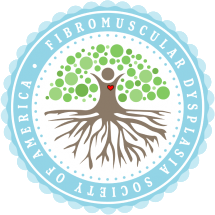Stigma, Fear, and Acceptance: Three Phases of the Fibromuscular Dysplasia Experience.
Bumpus SM, Krallman R, Heidt S, Kline-Rogers E.
JSM Atherosclerosis. 2017;2(1):1021.
Fibromuscular Dysplasia (FMD) is an arteriopathy that can affect any vascular territory, though most often affects the renal and carotid arterial beds. Symptoms are consistent with the vascular bed affected and are often attributed to other conditions, leading to delays in diagnosis. We present a case of a
middle-aged woman who presented to the emergency department (ED) with altered mental status and confusion, with an ED discharge diagnosis of altered mental state secondary to depression and alcohol abuse. During follow-up testing, she was diagnosed with hypertensive encephalopathy and, subsequently, FMD.
The true prevalence of FMD is unknown, although current estimates vary from 3-4%. Like other “uncommon” disorders, appropriate diagnoses are often delayed or missed altogether. This delay to diagnosis, in combination with non-specific symptoms and providers’ unfamiliarity with FMD, leads to frustration for many patients. A recent FMD qualitative publication revealed patients’ concerns about physical symptoms along with greater frequency of anxiety and depression. Importantly, these concerns decreased over time.
Through the work of many researchers, many health care institutions have created specialty centers for diagnosing and treating patients with FMD. There is now a strong community of patient support, partially due to the efforts of organizations like The Fibromuscular Society of America (fmdsa.org) and the U.S. Registry for FMD. This case illustrates that progress has been made in increasing the awareness of FMD and highlights that a lot of work still needs to be done.

 Since ancient times and across many cultures, the tree has long been a symbol of many things, including wisdom, protection, strength, inter-connectivity, and life itself. We’ve chosen the tree to represent the Fibromuscular Dysplasia Society of America for these reasons, and because the tree’s branches and roots signify the arteries affected by this disease. The tree’s branches, reaching upward and outward, provide protection and shelter, and represent our mission to help those who’ve been diagnosed with FMD. Trees, strengthened by their continuously spreading roots, symbolize how as we grow together we are stronger and more resilient. As with its growth from a delicate sapling to a giant robust tree, and as its branches and roots grow and spread, the tree symbol represents how we’ve evolved and continue to promote research, education and patient support throughout the years. Together we can achieve much, as we strive to reach for the sky.
Since ancient times and across many cultures, the tree has long been a symbol of many things, including wisdom, protection, strength, inter-connectivity, and life itself. We’ve chosen the tree to represent the Fibromuscular Dysplasia Society of America for these reasons, and because the tree’s branches and roots signify the arteries affected by this disease. The tree’s branches, reaching upward and outward, provide protection and shelter, and represent our mission to help those who’ve been diagnosed with FMD. Trees, strengthened by their continuously spreading roots, symbolize how as we grow together we are stronger and more resilient. As with its growth from a delicate sapling to a giant robust tree, and as its branches and roots grow and spread, the tree symbol represents how we’ve evolved and continue to promote research, education and patient support throughout the years. Together we can achieve much, as we strive to reach for the sky.